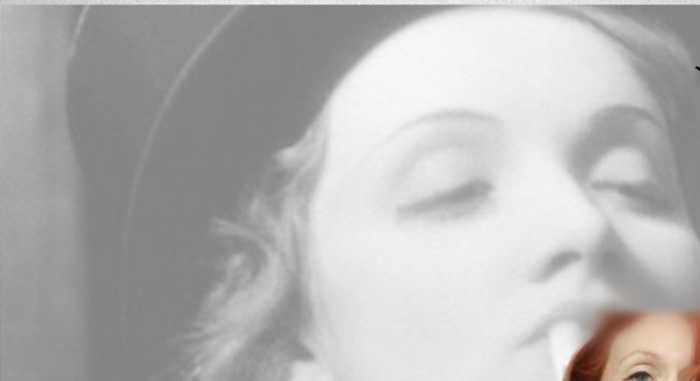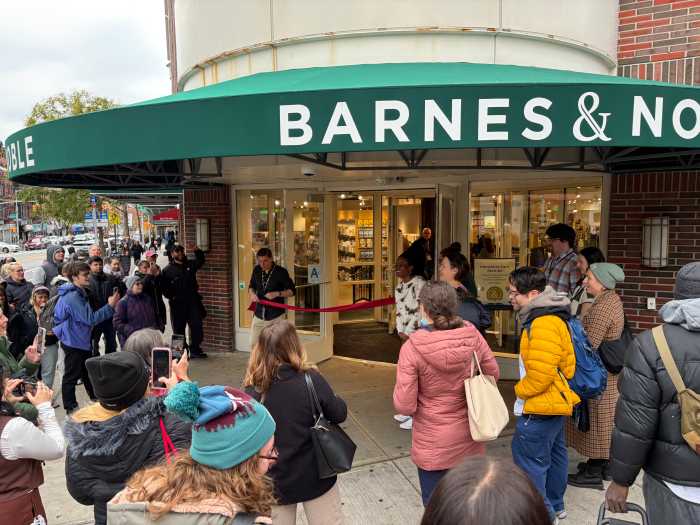BY DAVID NOH | With the weather still unreliable, what better way to hibernate than snuggling indoors with a good book. I got a plethora of them over the holidays, most of which dealt in some way with my favorite decade, the 1930s- an era with plenty of political and economic turmoil, but which certainly delivered the goods in other ways. With Hollywood's star system turning out classics, composers like Cole Porter and the Gershwins creating the Great American Songbook, a fervently alive Broadway, Deco architecture, superbly streamlined women's fashions that continue to inspire designers today, the best cars and luxury liners, it was an era of unsurpassed elegance and creativity.
Absolutely emblematic of the period was Joan Blondell, an underrated actress, who finally has a biography, written by Matthew Kennedy, “Joan Blondell: A Life Between Takes” (Mississippi University Press). Voluptuous and cherubic, she could have stepped out of a Rubens painting and incarnated the hard-working, tough-talking Depression gal for all time. She was the best screen partner for the brilliant dynamo James Cagney, with whom she was discovered on Broadway in “Penny Arcade” and subsequently made six films, a screen partnership that equaled that of Hepburn and Tracy or Powell and Loy.
American Magnani, Haines' homes, haute Hartnell, Jer-ree!
In “Blonde Crazy” Blondell and Cagney play a delicious pair of hustlers on the eternal make and in “Footlight Parade” she plays his lovelorn secretary. Her home studio, Warners, made her a virtual slave, underpaid and churning out nine films a year but, according to Kennedy, Blondell rarely complained, so concerned was she about how her being off the screen would impact the livelihoods of her casts and crews.
Once she left Warners, better opportunities came her way, like Elia Kazan's debut feature “A Tree Grows in Brooklyn,” for which she was denied even a nomination for the Oscar she deserved, and Edmund Goulding's singular noir “Nightmare Alley.” In these films, she showed an emotional richness and deeper humanity and these qualities, coupled with her salutary earthy humor, make her an American Magnani. Even in a subsidiary role, as in “Desk Set,” she is such a joyously fun presence that you almost wish the film would further explore her life as a sexily mature office worker, rather than focus on those bickering old farts, Hepburn and Tracy.
Off-screen, Blondell could be delightfully caustic, as when she described Ann Sothern as having “stolen my act,” or said of Jennifer Jones, “She confuses acting with deep knee bends.” But her most searing vitriol was saved for June Allyson, who stole her second husband, Dick Powell, away from her. In Blondell's well-received, gutsy 1972 autobiographical novel, “Center Door Fancy,” she slyly calls the Allyson character “Amy” (a reference to that actress' appearance in “Little Women”), and minces no words as she describes her as a connivingly ambitious, ruthless hustler, a far cry from that actress' pristine, Peter Pan-collared girl-next-door image.
Kennedy got the idea for his book from Blondell's son, Norman Powell, a TV producer, whom he had interviewed in conjunction with his previous book about the wonderful, forgotten director Edmund Goulding. I asked Kennedy the most revelatory thing he discovered about Blondell and he replied, “There isn't anything very juicy, like her being a chronic klepto or nymphomaniac. But I suppose the revelation was the confirmation that her qualities on-camera very much translated into real life. That warmth, sincerity, and humanity of her that bubbles across the camera was actually very much a part of who she was as a person. Time and again, people who worked with her spoke of her generosity and her humor. When they talked long enough, they would start crying, and maybe they'd only worked with her once, 30 years ago.
“Her training was in vaudeville, and what especially comes across in her Warners years was the flawless diction, timing, and ability to react perfectly. Whenever she spoke a line, it felt like it belonged to her; she had a way of delivering even ordinary lines that was totally unique and endearing. This amazing gift I think was, in part, why she so often made movies that weren't all that exciting. People cast her knowing that she could do something with material that wasn't all that wonderful: 'Here's a movie we gotta finish in two weeks. Let's give it to Blondell – she'll make something of it.' Her talent almost worked against her.”
So did her breasts, which, as famous in their day as Pamela Anderson's are now, caused censorship problems. Jack Warner, firing off a memo to director Archie Mayo, wrote, “We must put brassieres on Blondell and make her cover up her breasts because, otherwise, we are going to have these pictures stopped in a lot of places. I believe in showing their forms, but for Lord's sake, don't let those bulbs stick out.”
Kennedy said the “Holy Grail” of Blondell's career is the lost film “Convention City” (1933), a film so racy with its double-entendre ad-libbing, that it helped bring on the censoring Production Code and all prints of it were subsequently destroyed.
“Class Act: William Haines, Legendary Hollywood Decorator” by Peter Schifando and Jean H. Mathison (Pointed Leaf Press) is one of the most sumptuous coffee table books ever published, graced with dazzling full page photos of the interiors, making you feel like you are really walking through the famous rooms of George Cukor, Jack Warner, Edie Goetz, and Joan Crawford. Haines (1900-73), an MGM silent star who was openly gay, found his career drying up with the talkies and switched métiers to tremendous success, helped early on by gal-pal clients like Crawford and Carole Lombard.
His bold combinations of Regency antiques with his own daringly modern, ultra-comfortable designed furniture gave his work a highly identifiable stamp of eclectic luxe, and he invented what came to be known as “California Style.”
Haines became a darling of the most powerful Republican set, including the Reagans, the Bloomingdales, and the Walter Annenbergs. What a change from his darkest days of 1933, when he was arrested in a YMCA with a sailor he had picked up in Los Angeles' once-famous cruising ground, Pershing Square, or the time he and his lover of 50 years, Jimmie Shields (who committed suicide shortly after Haines' death), were nearly lynched by an angry mob who'd accused them of molesting an under-age neighborhood boy.
Have you ever wondered who, exactly, was responsible for Queen Elizabeth's signature expensively dowdy look of prim daywear and over-the-top evening gowns, always coupled with that ubiquitous purse? “Bedazzled!: Norman Hartnell, Sixty Years of Glamour and Fashion” by Michael Pick (Pointed Leaf Press) answers that question. Hartnell (1901-79) was always the Queen's go-to guy, be it for her 1947 wedding to Prince Phillip or her 1953 coronation. You unregenerate royalists will have a ball with this book, lavishly rife with shots of crowned heads sporting Hartnell's famous embroidery. For Lizzie's wedding dress he did various symbols of the countries of her Commonwealth – Scottish thistle, Australian wattle, Canadian maple leaf, and India's lotus.
Hartnell's sleeker work for couture and theater, which first made his name in the '20s and '30s, is also shimmeringly featured. Famously silent about his sexuality, he was knighted in 1977, never married, and famously stated his design ethos when he announced, “To me, simplicity is the death of the soul.”
Christine Ebersole was a total delight at Seth Rudetsky's “Chatterbox” at Don't Tell Mama on January 10. Once again reminding us that she hails from Winnetka (“an Indian word for 'Affluent Gentile'), she then disclosed that plans are still afoot to take “Grey Gardens” to London, although lately she has been working the makeup counter at Bloomingdale's (“Come and say 'Hi.' After 'Grey Gardens,' there's nowhere to go but down”).
It's kind of staggering to think that her career goes back to being Guinevere to Richard Burton in the 1980 revival of “Camelot:” “I went to audition for him, and there he was, in the perfect blue cashmere sweater that matched those eyes, and I was just trying not to lose it!” Ebersole moved to LA seeking work, but the job offers dried up and her agent broke it to her not so gently: “Christine, you're 44!” She found herself doing a tiny part in “Ally McBeal,” auditioning for the same person who, ten years earlier, had cast her and Rosie O'Donnell to star in a TV series.
“Since I only had one line, I didn't read the entire script and, in the courtroom scene, when Lucy Liu looked at me and said, 'You let that old woman speak!' I instinctively turned around to see who she was referring to. That broke up the extra sitting behind me but, afterwards, I was sitting in Dyan Cannon's dressing room, looking into her mirror. And you know, she looks like she's in a wind tunnel, and I found myself pulling my face up, wondering how a lift would look and suddenly stopped and said, 'Christine, you've gotta get out of this town!'”
Thank God she did, to win two Tonys and, at Seth's, accompanied by Scott Frankel, she sang “Around the World,” morphing instantaneously into Little Edie and investing the lyrics with every bit as much emotion as if she were already on a West End stage.
Icaught the raved-over Barb Jungr at Metropolitan Room (January 15) and was quite taken by this English eccentric. Her act basically paid tribute to a lot of white straight guys – Bob Dylan, Jacques Brel, Elvis – unusual in cabaret, but, apart from a lugubriously slow rendition of “Heartbreak Hotel,” I found myself surprisingly concurring with nightlife expert James Gavin, who told me, “I like interesting songs from every possible genre, actually, and I don't know a lot of the songs Barb sings. I'd much rather hear them than a program of boring standards.”
Her Dylan songs were especially well done, and she has an amusingly flaky wit: “This is seven o'clock on a Tuesday night. Tuesday. Not the sexiest night of the week. But we'll make do. I had to wait to come on because I was told that everyone was busy eating their pies” (a reference to the offerings from The Little Pie Company, which Metropolitan audiences ravenously gorge themselves on).
“Jerry Springer: the Opera” finally came to New York's Carnegie Hall (January 30) after opening in London, 2003. This concert version I heard was rather a try-out for a possible Broadway production, but all I can say is everyone should save their money. The time has definitely passed for any novelty allure this might have once possessed and hearing low-lifes obscenely brawl and operatically shriek about wanting to poo their pants was dubious, to say the least.
Act One ended with a tap dancing squad of Ku Klux Klan members (oh! the non-hilarity) and Harvey Keitel, as Jerry, seemed tentative in his first stage appearance in 20 years. But I've had a soft spot for him ever since the night we met at the ground-breaking gay disco 12 West and he got me high on contraband and advised me to study with both Stella Adler (whom he was with) and her hated rival, Strasberg.
Contact David Noh at Inthenoh@aol.com.
SUPPORT THE ADVERTISERS WHO SUPPORT GAY CITY

































